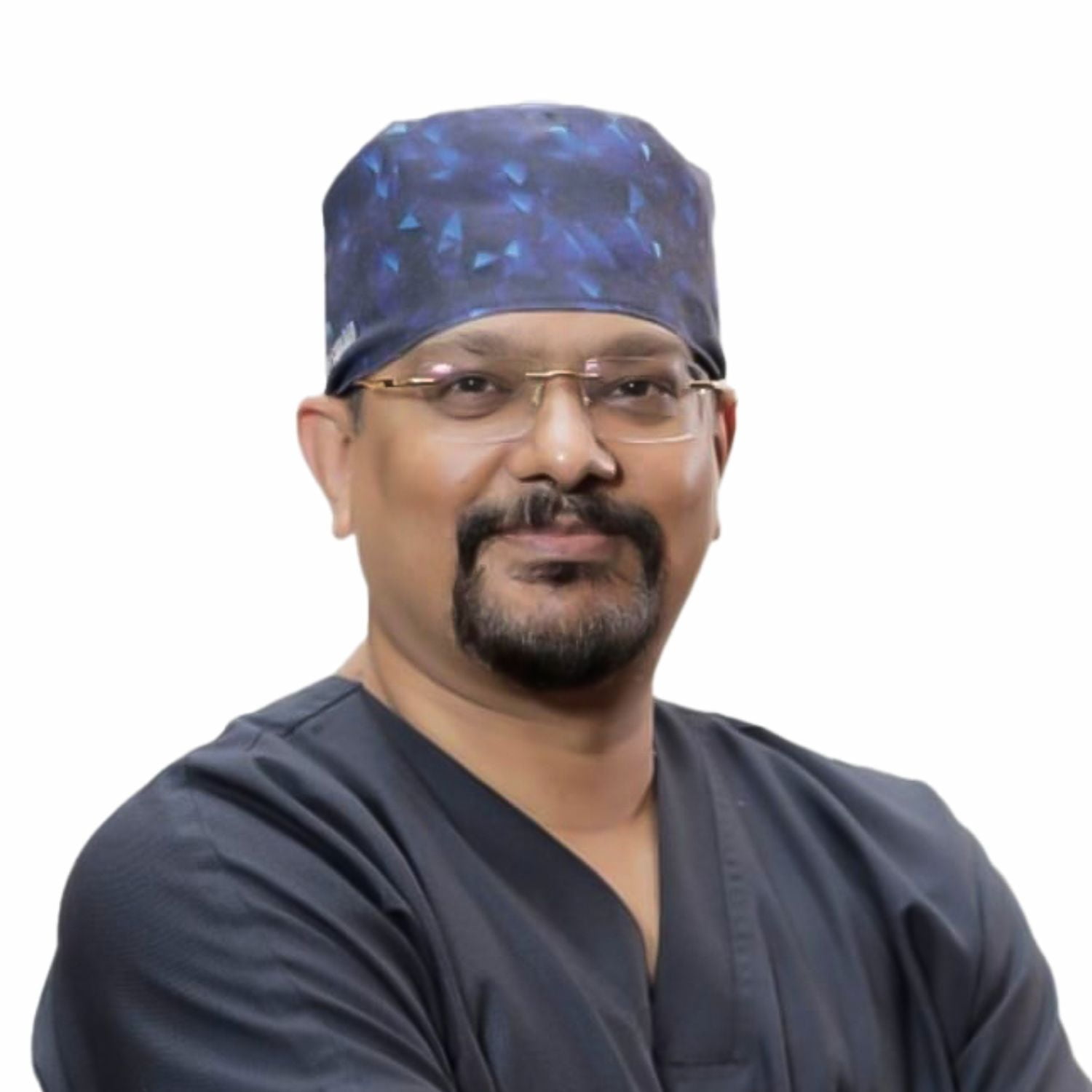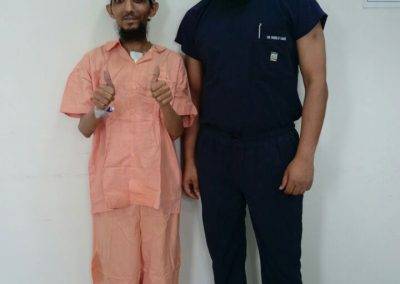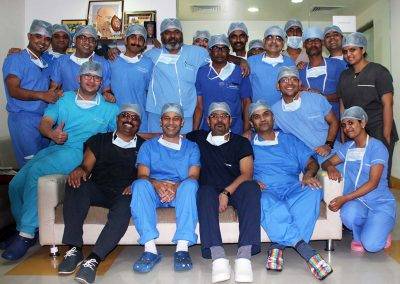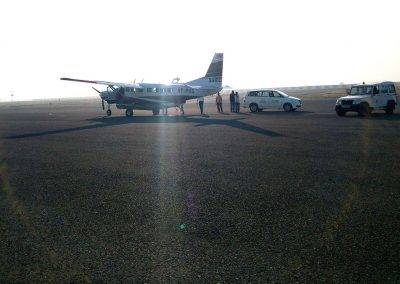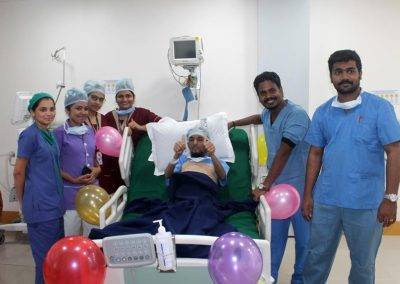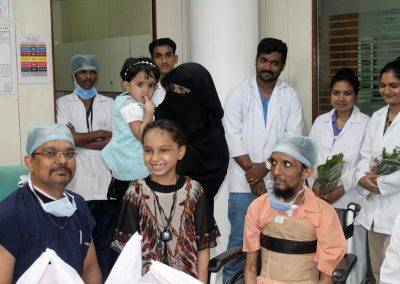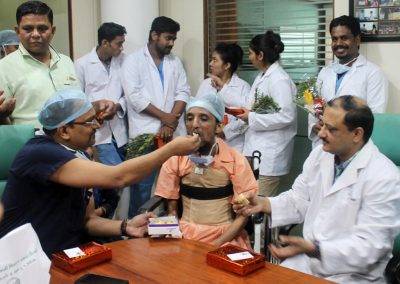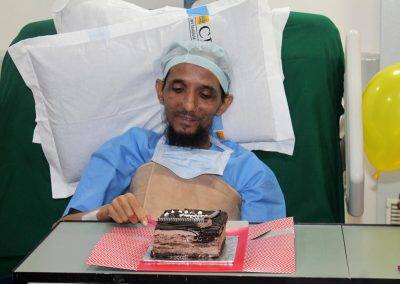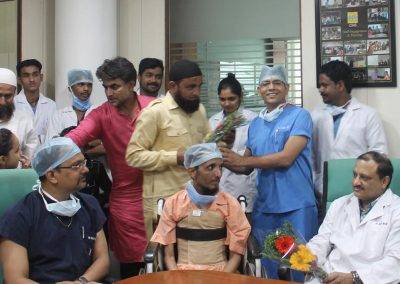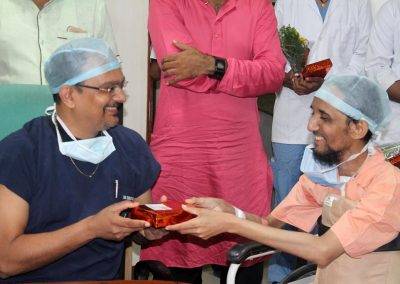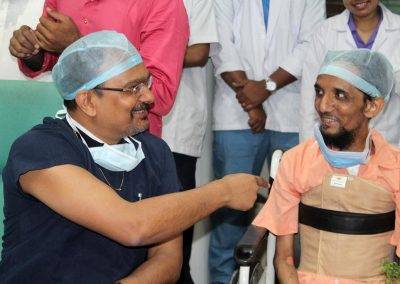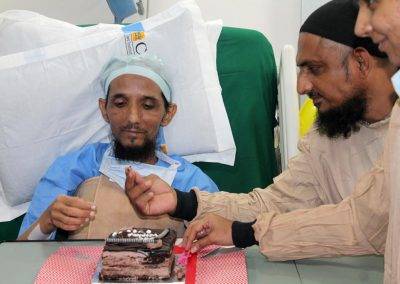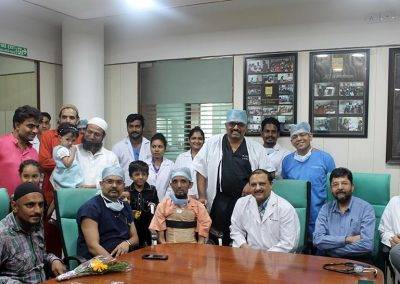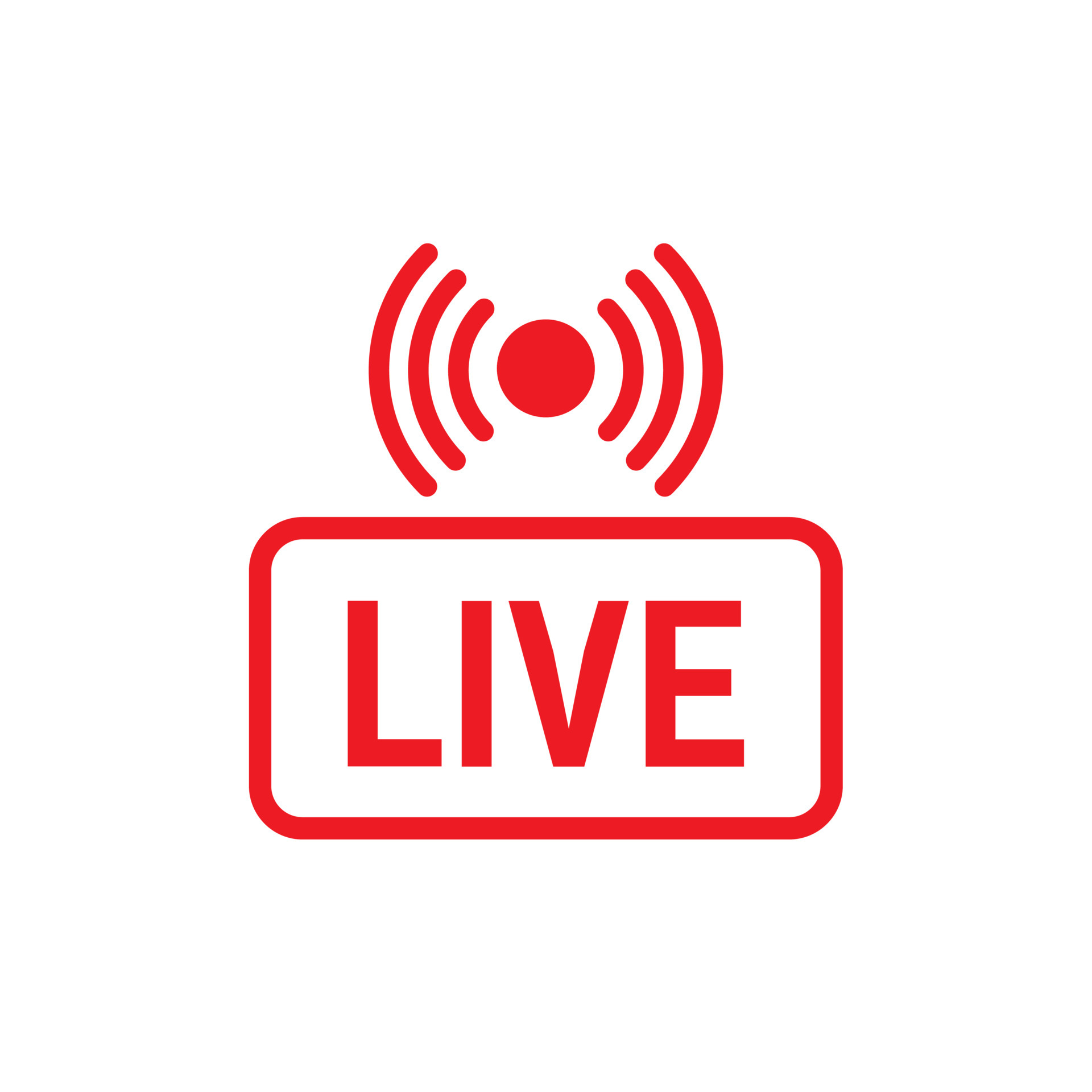Cardiac Surgery
Dr. Dhiren Shah guides you through the process of CABG heart surgery with a complete understanding of the process and videos from some of his best heart surgery cases in India.
CIMS Hospital is known as the best heart surgery hospital led by Dr. Dhiren Shah – amongst the best cardiac surgeons in Gujarat and recognised amongst the top heart failure doctors in India.
Where is the best place to get a CABG done in Gujarat?
CIMS Hospital is the best heart hospital under the leadership of Dhiren Shah amongst the best heart surgeons in Ahmedabad and Gujarat. Our team boasts to have the highest volume of heart transplants in Gujarat with a 99% success rate for CABG. As of July 2019 – most bypass surgeries at CIMS Hospital in Gujarat were exclusively performed by our expert cardiac surgeon Dr. Dhiren Shah and his team at CIMS Hospital in Ahmedabad.
What exactly is a Coronary Artery Bypass Graft Surgery?
CABG is a surgical procedure in which one or more blocked coronary arteries are bypassed by a blood vessel graft to restore normal blood flow to the heart. These grafts usually come from the patient’s own arteries and veins located in the chest (thoracic), leg (saphenous) or arm (radial). The graft goes around the blocked artery (or arteries) to create new pathways for oxygen-rich blood to flow to the heart. The goals of the procedure are to relieve symptoms of coronary artery disease (including angina), enable the patient to resume a normal lifestyle and to lower the risk of a heart attack or other heart problems. At CIMS Hospital, bypass surgery may be performed in combination with other heart surgeries, when necessary, such as valve surgery, aortic aneurysm surgery or surgery to treat atrial fibrillation (an irregular heart beat).
Who is eligible to receive coronary artery bypass graft surgery? ?
Diagnostic tests have helped your heart doctor identify the location, type and extent of your coronary artery disease. The results of these tests, the structure of your heart, your age, the severity of your symptoms, the presence of other medical conditions, and your lifestyle will help your cardiologist, surgeon and you determine what type of treatment is best. At CIMS Hospital, CABG surgery may be combined with other heart surgeries, such as valve surgery, aortic aneurysm surgery or surgery to treat atrial fibrillation (an irregular heartbeat) by Dr. Dhiren Shah and the best heart surgery team in Ahmedabad.
CABG
What happens during the cardiac bypass surgery?
- After general anesthesia is administered, the surgeon removes the veins or prepares the arteries for grafting.
- There are several types of bypass grafts.
- The surgeon decides which graft(s) to use, depending on the location of the blockage, the amount of the blockage and the size of the coronary arteries.
What kind of GRAFTS are used for bypass surgery?
- Internal mammary arteries [also called IMA grafts or internal thoracic arteries (ITA)] are the most common bypass grafts used, as they have shown the best long-term results. In most cases, these arteries can be kept intact at their origin because they have their own oxygen-rich blood supply, and then sewn to the coronary artery below the site of the blockage. If the surgeon removes the mammary artery from its origin, it is called a “free” mammary artery. Over the last decade, more than 90% of all patients received at least one internal artery graft. At CIMS Hospital, cardia surgeon Dr. Dhiren Shah prefers to use more of this conduits as it gives good long term results.
- The radial (arm) artery is another common type of arterial graft. There are two arteries in the arm, the ulnar and radial arteries. Most people receive blood to their arm from the ulnar artery and will not have any side effects if the radial artery is used. Careful preoperative and intraoperative tests determine if the radial artery can be used. If the radial artery is used as the graft, the patient may be required to take a calcium channel blocker medication for several months after surgery. This medication helps keep the artery open. Some people report numbness in the wrist after surgery. However, long-term sensory loss or numbness is uncommon.
- Saphenous veins can be used as bypass grafts. Minimally invasive saphenous vein removal does not require a long incision. One to two incisions are made at the knee and a small incision is made at the groin. This results in less scarring and a faster recovery. Dr. Dhiren Shah, the leading senior cardiac surgeon will decide if this method cardiac bypass surgery is a good option for you.
What are the risks of CABG?
As with any surgery, there are risks involved. Your surgical risks are related to your age, the presence of other medical conditions and the number of procedures you undergo during a single operation. Your cardiologist will discuss these risks with you before surgery; please ask questions to make sure you understand why the procedure is recommended and what all of the potential risks are.
What is the Surgical Procedure for CABG ?
Some complications can occur soon after the procedure, while others may develop months or even years later.
The main risks associated with a heart transplant are described below.
- Rejection
This is where the immune system recognises the transplanted heart as foreign and attacks it. Rejection usually occurs in the days, weeks or months after the transplant, although it can sometimes happen years later. Immunosuppressant medication can reduce the risk of this happening, but can’t always prevent it completely.
- Graft failure
In this the donated heart fails and doesn’t work properly. It occurs in 5-10% of people who’ve had a heart transplant, and can be fatal.
- Immunosuppressant side effects
The immunosuppressant medications needed to prevent rejection can have a number of significant side effects.
- Infections
Immunosuppressant medication will weaken patient’s immune system and make the patient more vulnerable to infection.
- Narrowed arteries
Narrowing and hardening of the blood vessels connected to the donor heart is a common long-term complication of a heart transplant.
What is a Heart-Lung Machine ?
During surgery, the heart-lung bypass machine (called “on-pump” surgery) is used to take over for the heart and lungs, allowing the circulation of blood throughout the rest of the body. The heart’s beating is stopped so the surgeon can perform the bypass procedure on a “still” heart. Off-pump or beating heart bypass surgery allows surgeons to perform surgery on the heart while it is still beating. The heart-lung machine is not used. The surgeon uses advanced operating equipment to stabilize (hold) portions of the heart and bypass the blocked artery in a highly controlled operative environment. Meanwhile, the rest of the heart keeps pumping and circulating blood to the body.
Receiving a new heart can improve quality of life considerably, but one has to take good care of it. In addition to taking daily anti-rejection medications, the recipient needs to follow a heart-healthy diet and lifestyle as prescribed by doctor. This includes not smoking and exercising on a regular basis.
What is Pre Surgery of CABG ?
- You will be admitted one or two days prior to the operation. Sometimes, the surgery can be performed on the same day of admission. In either case, following is the pre operative protocol performed on all patients. u A blood and urine test will be done to ascertain that everything is in proper balance and to ascertain baseline values.
- A chest X-ray and an electrocardiogram will be taken. u A lung function test will be done. u A solution will be given for oral care. u The anesthesiologist will meet you before surgery and order pre-operative medications for the day of the surgery. This medication causes drowsiness, but you will not be completely sedated at this time.
- The physiotherapist (your case co-ordinator) will visit and explain about exercise to be performed during and after hospitalization. A member of the surgical team, will visit the patient and family to explain what the surgery is all about and what will happen in the Intensive Care Unit (ICU) when one awakes after surgery.
- It is strongly advised that the patient visit the ICU before surgery, so that when the patient wakes up after surgery, he does not find himself in an unknown area.
What is Minimally Invasive Technique for CABG?
Minimally invasive coronary artery bypass (MIDCAB) surgery is an option for some patients who require a left internal mammary artery (LIMA) bypass graft to the left anterior descending (LAD) artery. Other minimally invasive surgery techniques include endoscopic or keyhole approaches (also called port access, thoracoscopic or video-assisted surgery) and robotic-assisted surgery.
The benefits of minimally invasive surgery include a smaller incision (3 to 4 inches instead of the 6- to 8-inch incision with traditional surgery) and smaller scars. Other possible benefits may include a reduced risk of infection, less bleeding, less pain and trauma, decreased length of stay in the hospital (3 to 5 days) and decreased recovery time.
The surgical team will carefully compare the advantages and disadvantages of minimally invasive CABG surgery versus traditional CABG surgery. Your surgeon will review the results of your diagnostic tests before your surgery t
CABG SURGERY DAY
What happens the day of the surgery?
- An hour before you are wheeled into the operation theater, you will be called into the ICU & will receive a preoperative antibiotic injection to prevent infection and an injection which will help you relax and make a little drowsy.
- Once wheeled into the operating room, one will not be put to sleep i.e. anesthized for about 15-20 minutes.
- The anesthesiologist will prepare you by putting in several lines. Certain discomfort may be experienced, while the lines are being inserted.
- One or two lines are inserted in one of the arms. u An arterial line is inserted into the artery of the wrist to monitor blood pressure.
- Another line, Swan Ganz catheter or Triple lumen catheter will be inserted into large vein in the neck after anaesthetisation which monitors the heart pressures during the operation.
- Once all lines are inserted, you will be anesthetised through medication given into the IV lines.
- After anaesthesia, a breathing tube is inserted through mouth or nose, and the operation begins.
RECOVERY
What happens in the ICU after surgery?
- You will be brought directly to the ICU from the operation theater. You will feel drowsy and be sedated for 4-6 hrs after the operation due to effects of anesthesia. The breathing will be mechanically assisted by a ventilator with oxygen going in through the tube. Normally, one person of the family can visit the patient in the ICU one to two hours after the operation. Many tubes will be attached to the patients body soon after the operation such as: 1. Nasogastric tube (Stomach tube): It will be put in the nose, going down into the stomach to prevent gastric distention and nausea. This tube causes no pain but may cause some post-nasal drip. The tube may be removed the next morning. 2. Breathing (endotracheal or E.T) tube: Connected to a ventilator or (breathing machine) the purpose is to ensure deep breaths and make it easier to breathe.
- When you awaken you will not be able to talk because the breathing tube goes down between the vocal cords.
- You will be able to communicate by writing notes or nodding your head. u Hands may be gently restrained to remind you not to pull tube out.
- Suctioning of the breathing tube will be done, as needed, to remove secretions and prevent pulmonary problems.
- A coughing sensation may be experienced when the breathing tube is suctioned. u The tube will be removed as soon as you are awake and breathing adequately on your own.
- Once tube is removed, your throat may be sore and you may be hoarse.
- When you cough out sputum, it may be blood tinged due to irritation from the tube. All of these conditions are temporary and normal. 3. Foley catheter: It will be inserted into your bladder while you are asleep to accurately measure and record urine output. You may still feel the urge to urinate even with the catheter. It will be removed on the 2nd postoperative day. There may be a burning sensation the first time you urinate after the Foley catheter is removed. 4. One or two tubes will be inserted in your chest at the end of the operation. The purpose of the chest tube(s) is to prevent accumulation of fluid in the chest cavity. Chest tube(s) will be gently squeezed or milked to ensure adequate drainage. When the family comes in to visit they will see drainage container at the foot of the bed with some bloody drainage in it. This is entirely normal. The chest tube(s) will be removed when the drainage stops, usually on the second day. 5. An arterial line is a soft plastic needle that is inserted into the radial artery in the wrist to monitor the blood pressure. For the first day any blood sample that are necessary for tests can be drawn from the arterial line. It is usually removed on the first postoperative day. 6. IV lines will give you fluid, medications, and blood when needed. The IVs are removed the morning after surgery. u Once fully awake, you will be taken off the ventilator and allowed to breathe on your own. The breathing mask, which supplies humidified oxygen, will still be in place on your face.
- The nasogastric tube will be removed.
- You will be taught how to perform coughing and deep breathing exercise. This exercise may seem uncomfortable but is beneficial and will not cause any damage to the heart, grafts or incisions.
- You will be turned from side to side at least every four hours to relieve pressure areas.
What happens in the ICU after you wake up?
- Once fully awake, you will be taken off the ventilator and allowed to breathe on your own. The breathing mask, which supplies humidified oxygen, will still be in place on your face.
- The nasogastric tube will be removed.
- You will be taught how to perform coughing and deep breathing exercise. This exercise may seem uncomfortable but is beneficial and will not cause any damage to the heart, grafts or incisions.
- You will be turned from side to side at least every four hours to relieve pressure areas.
- Clear liquids will be given several hours after the breathing tubes have been removed and then there will be a gradual progress to a regular diet.
- If the condition is stable, some of the monitoring lines will be removed. The only line left will be an IV or heparin lock.
- The chest tube(s) remains in place for 4-5 days.
What happens on the second day?
- Depending on the medical condition, the following protocol will be observed on the second day.
- Once the patient acquires an appetite, he can begin to eat regular food, but the fluid intake will be limited to 6 cups (48oz.) to 8 cups (64oz.) in 24 hours.
- One of the chest tube(s) will be removed. Pain medication will be given prior to this procedure.
- You may have one or two tubes attached to a bag which can be carried.
- Foley catheter will be removed on the 2nd day after surgery.
- Chest physical therapy will begin as indicated. u After the chest tube(s) have been removed, you will be assisted out of bed and into the chair.
- One may experience tiredness and fatigue as a result of stay in the ICU. Depression and discomfort is common. But it is important to let the nurse know so that she/he can administer pain medication. If the comfort level is satisfactory it will be easier to do breathing and coughing exercise and to get out of bed and walk.
- You will be shifted to room/ward after 2-3 days depending upon surgery & recovery.
Expectations: Postoperative Discomfort and Expected Minor Complications ?
Pain
It is natural to have aches and pains after surgery. Your physician will prescribe pain medication, which should be taken when needed. The nurses will ask you if you have pain in either chest or leg incision, but it is your responsibility to ask the nurse for pain medication. A good time to request the pain medication is 15-20 minutes before beginning your breathing exercises.
Pericarditis
The pericardium is a thin lining (sac) around the heart that is opened during the surgery. Normally, there is a small amount of fluid in the pericardial sac, and the heart moves easily within it. The sac may become inflamed and irritated as a result of the surgery, and this will cause discomfort in the chest, shoulder and neck. The soreness can be mild to severe. Sweating may occur especially at night. The discomfort can increase with deep breathing, coughing, or lying down. It can be treated with one of several anti-inflammatory drugs or steroids. The discomfort subsides within a few days and the medication can be discontinued within a few weeks.
Dysrhythmias
Dysrhythmias, or irregular heartbeats, can occur after surgery in 30 % of patients & in particular old age patients. The patient may feel that his heart is racing, palpitating, or doing flip-flops. There is no need to panic. Notify the nurse. An electrocardiogram may be done and, if necessary, medication will be started.
Depression
This is a most common post-operative syndrome and can last for several days, or even months, after the operation. Sleep can be difficult in the ICU. There are noises, people and activity in the ICU 24 hours a day. You, may therefore feel tired, irritable, grumpy and even depressed. As one catches up on sleep after being shifted into the room, and the time of discharge approaches, the depression usually lessens or disappear.
Coughing
After surgery, coughing and taking deep breaths might be painful, but coughing is extremely important. Deep breathing is essential so that secretions do not build up in the lungs which could lead to a partial collapse of lungs, or even pneumonia. By coughing and deep breathing, secretions are discharged, thus keeping the lungs clear.
Bleeding
Bleeding can occur after surgery. The drainage from the chest tube(s) is observed closely for any signs of excessive bleeding. Occasionally a patient is returned to the operating room for control of the bleeding. The procedure takes about an hour. The patient is returned to the ICU. This can occur in 20 % of cases after the procedure & is normal.
What are the remaining days in the hospital like?
The day you are transferred to the regular unit, you should walk in your room and sit in a chair two or three times. The next day, you should walk in the hallway; at first, walk with assistance until you are more steady on your feet. Do lot of exercise & physiotherapy. For the remainder of your hospital stay you should start walking more and more in the hallway. By the time you leave the hospital you may be able to walk up to one mile a day (not all at one time) and climb 7-8 steps. You may not feel like eating for a few days which is normal because of antibiotics & medicines. You will probably be ready to leave the hospital 6 to 10 days after your surgery. The remainder of your recovery will take about four to eight weeks at home.
What is the procedure from Hospital to Home like?
It is extremely normal to feel anxious or depressed about leaving the hospital which has provided you with a sense of security. Do not forget, that you will not be discharged until the doctors are confident of your fitness to go home. Once home, try to resume a normal routine. It is important to arise at a reasonable time, have a bath and dress in clean clothes. This simple act will help you greatly in feeling normal and aid your recovery process.
It is advisable to discuss with your doctors the apprehensions you and your family feel. The following points need to kept in mind while going home:
- Appointments for check ups. On the day of discharge, you should fix up an appointment with your heart surgeon/cardiologist for check-ups. u The surgeon might want to see you 4 weeks post-discharge.
- Your cardiologist/family physician will be responsible after the surgeon has discharged you and the post-operative visits are over.
- You should contact the surgeon’s office, if any problems arise before the next appointment.
- Take appointments with your local doctor & family physicians after returning home.
Are there dietary guidelines to follow?
1. Patient should maintain slightly lower than the standard weight. Accordingly, total calories should be restricted.
2. The diet should be rich in fiber including foods like raw salads, fruits, green leafy vegetables and whole grains.
3. Five servings of fruits and vegetables should be included in the diet not only to meet the nutritional requirement but also to meet antioxidants and fibre.
4. Consumption of two or more oils help in obtaining the optimal ratio of different fatty acids.
5. Inclusion of fish in the diet is beneficial as they contain omega-3 fatty acids.
6. Concentrated foods like sweets, chocolates, cakes, pastries, ice creams and fried foods should be restricted.
7. Foods giving only empty calories like carbohydrated beverages, alcohol, sugar and sago are to be totally avoided.
8. Small quantities of almond can be consumed to bring down the cholesterol levels. High amounts of nuts and oil seeds increase the calories and fat content in the diet.
9. Coconut should be avoided in the diet as it contains high amount of saturated fatty acids and it is a concentrated source of energy.
10. Coffee and tea can be taken in moderation. Excess amount of caffeine can increase the heart rate.
11. Animal foods like meat and pork which contain high amount of saturated fat should be avoided. All sea foods are rich in sodium, hence hypertensive patients should avoid these foods.
12. Foods that have hypercholesterolamic effects like soyabean, fenugreek, garlic, onion and turmeric should be included in the diet.
13. Heavy meals should be avoided. Small and frequent meals are preferred.
14. Taking outside meals are to be avoided as they are mostly high in fat.
15. Constipation should be prevented by including plenty of water and fiber in the diet. Best cooking oils : (1) For deep frying foods : The best oils are those with a high smoke point such as canola oil, corn oil, safflower oil and sunflower oil (2) For stir frying and salad dressing : Any oil low in saturated fat like canola oil,
Can I do house work?
It is only after the checkup with the surgeon, one should assume household responsibilities such as cooking meals, or taking care of children. As one feel stronger, one can help with light household duties such as dusting, setting and clearing the table or lending a hand in cooking. One should avoid strenuous activites such as moving furniture, vacumming, scrubbing floors, gardening, lifting objects greater than 10lbs. until cleared by the doctor. Avoid any activity that causes incision discomfort or causes tiredness easily.
When can I get back to work?
This perhaps, is one of the most important questions that patient’s have post surgery. After the surgeon gives his consent after the 4-week check up, most patients can return to work in 6-10 weeks, depending on the occupation. After a one month follow-up with surgeon and the cardiologists opinion, one can resume work slowly with light duty initially.
It is advisable to discuss with your doctors the apprehensions you and your family feel. The following points need to kept in mind while going home:
- Appointments for check ups. On the day of discharge, you should fix up an appointment with your heart surgeon/cardiologist for check-ups. u The surgeon might want to see you 4 weeks post-discharge.
- Your cardiologist/family physician will be responsible after the surgeon has discharged you and the post-operative visits are over.
- You should contact the surgeon’s office, if any problems arise before the next appointment.
- Take appointments with your local doctor & family physicians after returning home.
Post Surgery Guide Information
Use this section of the website to get additional information resources and knwowledge that can help improve your life after a bypass heart surgery.
You may find it difficult to remember things or to concentrate after surgery. Full functioning of memory and concentration abilities is achieved within a few weeks. Remember your heart has been fixed, not your brain so there are not going to be memory related permanent issues.
Vision change is common post operatively. This is due to use of the heart lung machine used during surgery. Do not rush to get glasses for vision correction. These changes correct themselves within six months of the surgery. If vision or mental function change persists , one should notify the family physician.
The body needs more sleep during the healing period. It is essential to get 8-10 hours of sleep at night. During the day, rest periods are essential. One should not indulge in activity for more than 2-3 hours. Resting after 2-3 hours of work is necessary to avoid strain. It is not necessary to sleep during the rest periods, one can just relax. Visitors at home should be limited, especially during the first two weeks at home.
One can climb stairs, but one has to do it slowly. One should rest if one becomes tired, short of breath or dizzy. It is better to limit climbing stairs to two to three times a day for the first two weeks.
The average demand on the heart during intercourse is equivalent to walking briskly for several minutes along with climbing two flights of stairs. One can indulge in sexual activity after heart surgery. It is a common fear that one may experience difficulty in getting or maintaining an erection, lack of stamina or trouble having an orgasm. Sexual activity can be resumed after the return visit to the surgeon. It should be indulged only after the partner is well rested, not eaten a heavy meal and is relaxed. One should be in a more passive position and not place weight on the arms for the first six weeks. The breastbone requires approximately 6-8 weeks to heal and strain should be avoided during this period.
Smoking has to be completely stopped. Smoking increases the heart rate, narrows the blood vessels, raises blood pressure and affects the lungs. It is difficult to quit smoking but it is extremely important to do so.
One can drink coffee or tea but not more than two cups a day. Cola drinks, chocolate, tea and some pain medications contain caffeine or caffeine-like substances- so include them in calculating the intake of two cups a day. Stay away from non-dairy creamer and cream in coffee, as these contain considerable amounts of saturated fats. Try to use non-fat powdered milk, 1% low fat milk, skim milk or evaporated milk. Black tea or coffee would be an ideal drinking choice. Initially after surgery, one may not have much of an appetite, which will improve over time.
It is important to maintain an adequate and nutritious diet after surgery.to quicken the process of healing, and gaining strength and good health. Iron is an essential for recuperation.
Too much fat and the wrong kind of fat can be harmful to the body. Saturated fat increases the level of cholesterol in the blood. Saturated fat is usually sold at room temperature and mostly found in most animal foods such as
- White of milk or 2% milk
- Butter & Cheese
- Meat
- Some vegetable products such as coconut and palm oil
- Chocolate Some saturated fats can be made from unsaturated fats through a chemical process called hydrogenation which should be avoided.
- Polusunsaturated fats lower the level of cholesterol in the blood. These fats are from vegetable sources and some of them are: (1) Sunflower oil (2) Soyabean oil (3) Sesame seed oil (4) Safflower oil (5) Cottonseed oil (6) Corn oil The diet should be planned in consultation with the cardiologist/family physician.
If the patient is constipated after discharge, laxative can be taken. Isabgol is best for constipation and should be taken daily at night time. Increase the intake of fluids, green vegetable and fruits. If discharged on an iron pill, the bowel movements will be black.
It is extremely common to feel depressed after surgery. However there is a difference. Being depressed is different from clinical depression which is a condition wherein a patient is depressed, but also is prone to other symptoms such as insomnia, appetite disturbances, fatigue, lethargy, lack of interest in pleasure-giving things including sexual intercourse and feelings of hopelessness and despair. Suicidal thought too can occur. If such symptoms occur, the physician should be contacted so that treatment can be commenced.
Physical activities (tennis, swimming, bowling, golf) other than walking should be postponed for 10-12 weeks. Physical activities which do not involve exertion can be indulged in such as playing cards, going out for dinner, movies or theatre, or social visits can be indulged in.
Resources
CABG Movies
Heart Transplant Video in English
(300 MB+. Watch with fast internet only or download for offline viewing)
Heart Transplant Video in Hindi
(97 MB+. Watch with fast internet only or download for offline viewing)
6th Heart Transplant Video
(191 MB+. Watch with fast internet only or download for offline viewing)
Heart Transplant Video with former Gujarat Chief Minister Vijay Rupani
(166 MB+. Watch with fast internet only or download for offline viewing)
Dr. Dhiren Shah Talks about Heart Failure
(200 MB+. Watch with fast internet only or download for offline viewing)
